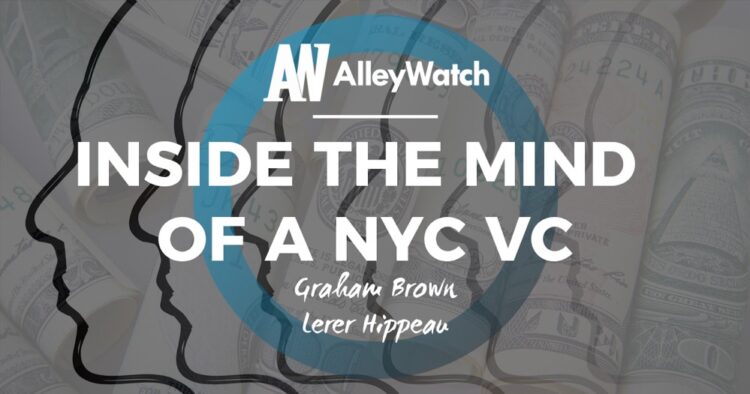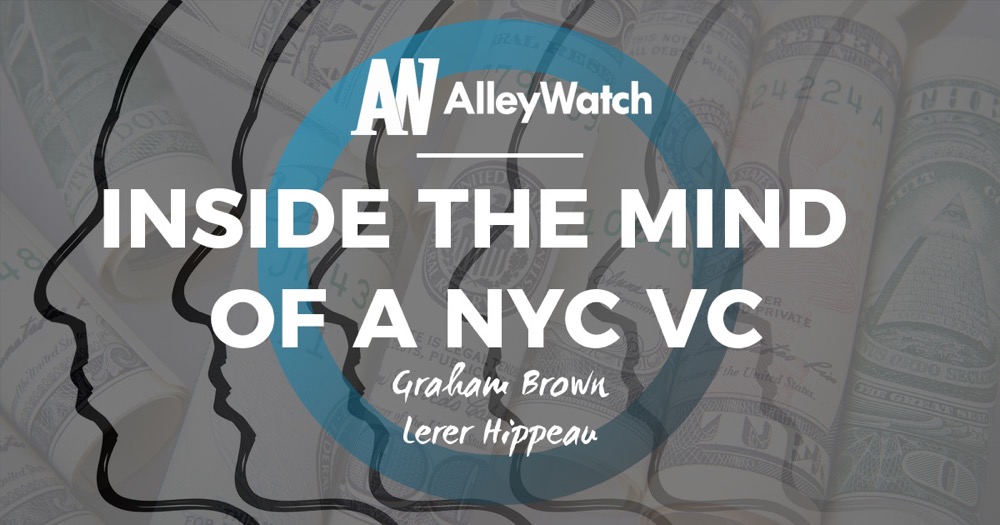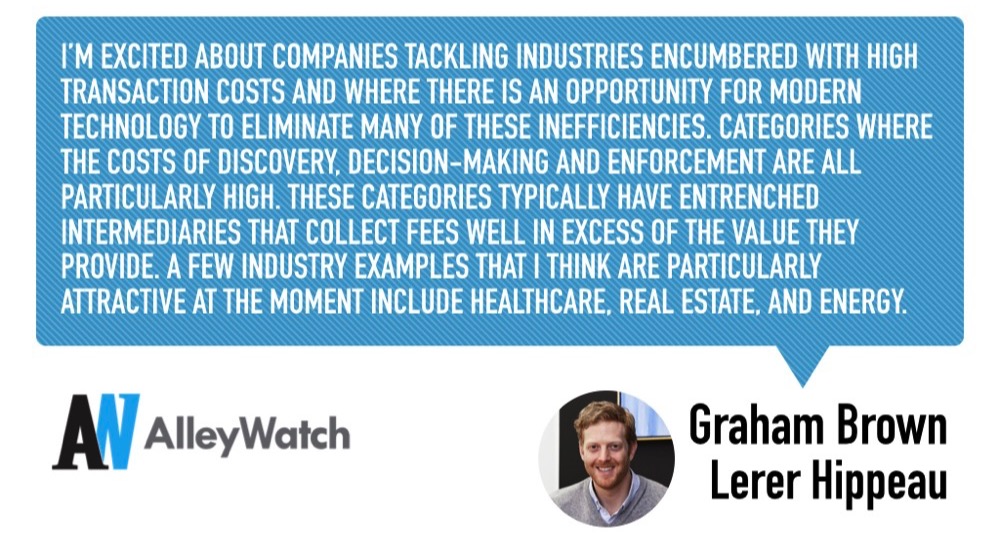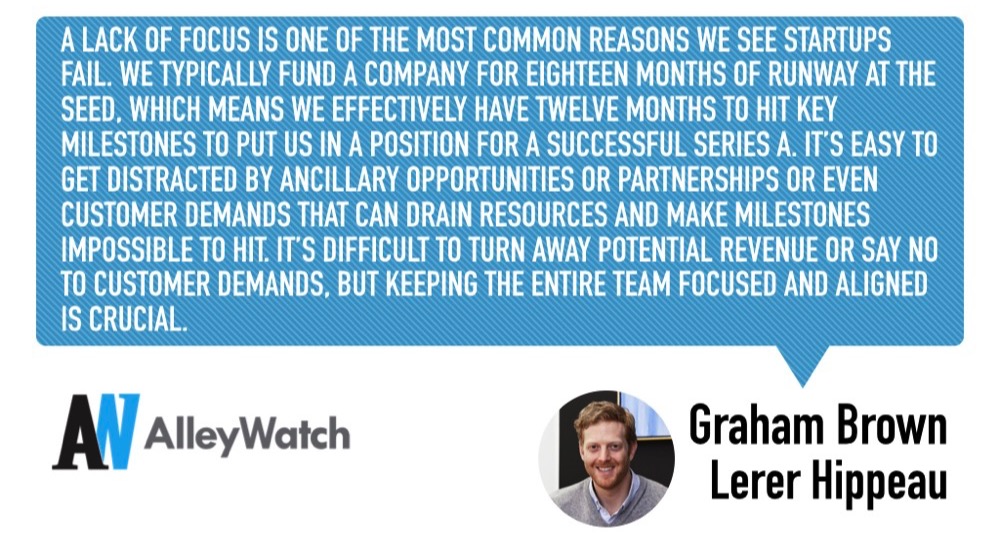Welcome back to Inside the Mind of an NYC VC, a highly acclaimed series at AlleyWatch in which we speak with New York City-based Venture Capitalists. In the hot seat today is Graham Brown, a Partner at Lerer Hippeau, the early-stage venture firm founded by Ken Lerer, Eric Hippeau, and Ben Lerer in 2010. Lerer Hippeau has been the most active seed stage investor in New York with 400+ investments, with two-thirds of its portfolio companies calling New York home. The firm’s investments include some of the city’s most prized startups including BuzzFeed, Casper, Glossier, Joor, Oscar, Refinery29, SeatGeek, Warby Parker, and Fundera. With 80+ exits under its belt in companies like Sailthru, Venmo, Grovo, Moat, Tapad, Songza, GroupMe, Plated, and Group Commerce, Lerer Hippeau has been a guiding force and catalyst for the emergence of New York Tech.
Brown joined Lerer Hippeau in the fall of 2015 from SoftBank, moving up the ranks from Senior Associate to Partner at the firm in 2017. He leads the firm’s main fund ($122M) as well as its Select Fund ($60M), both of which closed last year. We visited Graham at the Lerer Hippeau offices, nestled on Crosby Street in Soho, for a candid and insightful conversation to learn more about his path to venture, how his responsibilities and investment outlook have evolved throughout his venture career, the state of the New York Tech ecosystem and where Lerer Hippeau fits, the SoftBank effect, compelling investments themes, advice to entrepreneurs, and much more…
If you are a NYC-based VC interested in participating in this series, please send us an email. We’d love to chat. If you are interested in sponsoring this series that showcases the leading minds in venture in NYC, we’d also love to chat. Send us a note
Reza Chowdhury, AlleyWatch: Please tell us a little bit about your background and how/why you started in venture.
Graham Brown, Lerer Hippeau: My career path in venture has uniquely trended earlier and earlier-stage over time. I started as part of the growth equity team at a multi-stage fund in Boston called Polaris Partners. It was 2008, and right around the time of Sequoia’s “RIP: Good Times”, so my timing was either really good (I got a job before the hiring freeze) or really bad (investing pace universally slowed) depending on how you look at it. Our group wrote slightly larger checks ($20M+) and we were looking for more mature, predominantly bootstrapped technology businesses. I cut my investing teeth at Polaris and was fortunate to have great exposure to both early-stage technology and life sciences investing. We were very thesis-driven, and I learned a ton about conducting effective market research and thoughtfully prospecting markets for unique opportunities.
My time in Boston really helped shape my investment lens (which is constantly evolving) and evaluation process for identifying compelling businesses. While at Polaris, I was fortunate to work closely with a number of our investments. Ultimately, I joined a portfolio company, Life Line Screening, in 2012 to help build out e-commerce and the company’s digital brand. It was a pretty amazing life experience that took me to Austin, where I immersed myself within healthcare and the evolution of preventive care. It was a crucial experience for me to see the other side of a boardroom and take on actual P&L responsibility. From there, I made my way to grad school at Columbia and joined SoftBank Capital in New York in 2014. This was pre-Vision Fund and the team I joined was focused on traditional early-stage (seed through Series B) opportunities. Over this time period, I fell in love with the New York ecosystem and joined Lerer Hippeau in late 2015.
 You’ve quickly ascended at Lerer Hippeau, starting as a Senior Associate back in 2015, then Principal, and now you’ve spent a year as a Partner. Congrats! How do these roles differ? Where do you spend the bulk of your time now versus before?
You’ve quickly ascended at Lerer Hippeau, starting as a Senior Associate back in 2015, then Principal, and now you’ve spent a year as a Partner. Congrats! How do these roles differ? Where do you spend the bulk of your time now versus before?
We’re a relatively flat organization, and as a result, the responsibility and autonomy you have at the senior associate level is pretty significant. While my role has certainly evolved, my typical day is still largely made up of meeting with founders, evaluating new investment opportunities, and spending time with our portfolio. The most significant change is the amount of time I now spend with LPs and on overall fund strategy. More and more it’s about taking a step back and thinking through the longer-term vision of what we’re building at Lerer Hippeau and how to best achieve our goals. It has been an exciting three years and the fund and team have both grown substantially since I joined in 2015.
Tell us a bit more about Lerer Hippeau and what its like to work with Ken, Ben, and Eric on a daily basis.
Lerer Hippeau is the most active early-stage venture capital fund in New York. Working with Ken, Ben and Eric is a blast. Not only do I love my job, but get to I learn from my partners every day. As a team, we all share the same mission in what we’re building at Lerer Hippeau, but each individual has a unique investment lens based on experience and personality. It’s a great balance and, as a partnership that spans multiple generations, we rely on each other’s perspective when evaluating new investment opportunities and supporting the portfolio. Having access to my partners’ knowledge that they have gained by investing and operating across cycles helps me tremendously as I continue to refine my skills as an investor.
Lerer Hippeau is the most active seed fund in NYC, backing the greatest number of NYC-based companies. It seems as though in 2018, the firm placed a conscious emphasis on its roots and positioning in the NYC market. Why the New York focus? Any thoughts on the “rise of the rest’?
We continue to see tremendous potential in New York and are just as excited about the ecosystem now as we were when we raised our first fund in 2010. The diversity of thought and talent in New York has always been a strength, and this underpins an evolving ecosystem that is positioned at the confluence of modern technology and the largest market in the U.S. Regarding the “rise of the rest”, there has been a general flattening in the U.S. (and world). While there are benefits to starting a company in a major market, increasing access to capital and ease of scaling remote talent has made it easier to build a successful company anywhere. Although a majority of our portfolio is headquartered in major hubs, we’ve recently invested in a variety of smaller markets including Charleston, San Antonio, Miami, and Toronto.
What have you observed in New York tech over the last few years? What are you excited about? What can be improved? How has New York Tech evolved since you started?
We’ve witnessed a general maturation of the technology ecosystem in New York. The city has evolved substantially from its adtech and fintech roots. It has been the central market for direct-to-consumer brands since 2010 and we’re seeing growing pockets of innovation around robotics, AI, and security. As software continues to infiltrate major industries, I’m excited about New York’s position as the largest market for healthcare, real estate, retail, financial services, mobility, etc., and what this means for startup opportunity across these major verticals. There’s a ton of room for growth for the New York tech community and it’s crucial for founders, investors, and stakeholders to support this community and help ensure we’re fostering talent and attracting new talent.
What trends defined 2018 in terms of tech and what themes do you expect to be relevant for 2019?
The general industry trend of fewer companies raising larger amounts of capital continued in force in 2018. New York tech had a record year with $13B in funding despite the number of deals declining. Not only is the average deal size increasing across stages, but there were more $100M+ rounds in 2018 than ever before. As venture firms raise larger and larger funds and continue to move upstream, we see a compelling opportunity and greater need to stay focused on early-stage investing. While there remain a number of macro uncertainties that will impact tech in 2019, I expect New York to have another record year.
The firm is investing out of Fund VI presently. Where is Lerer Hippeau’s sweet spot for investing?
We have a lot of flexibility in check size depending on the stage and financing needs of a particular company. To apply a range, we have made recent investments as small as $300K and as large as $2M, typically as the lead investor in a round. In terms of overall fund construction, we think about making roughly 50 investments with an average initial check size of $1M.
You lead the firm’s Select Fund as well as looking at other opportunities in the main fund. How does your evaluation differ in these two instances?
We evaluate two primary types of investments out of our Select Fund. The first being later-stage rounds (typically B and later) in existing portfolio companies that we initially invested in out of our seed fund. Our active involvement in these companies enables us to know when one is positioned to break out and we use our Select Fund to provide continuity when we are tapped out with seed fund reserves. In these cases, we have a multi-year history with the founders, substantial data around performance relative to expectations, and insight into the market opportunity that has evolved through our involvement. The second type of investment is in early-stage companies funded by others at the seed stage. These are typically Series A companies that fit our investment strategy and approach, and that we likely spent time with when they raised their seed. While there’s not only more data to evaluate than a typical seed investment, we’ve also had the chance to track the story over time and see the GTM evolve.
We evaluate two primary types of investments out of our Select Fund. The first being later-stage rounds (typically B and later) in existing portfolio companies that we initially invested in out of our seed fund. Our active involvement in these companies enables us to know when one is positioned to break out and we use our Select Fund to provide continuity when we are tapped out with seed fund reserves. In these cases, we have a multi-year history with the founders, substantial data around performance relative to expectations, and insight into the market opportunity that has evolved through our involvement. The second type of investment is in early-stage companies funded by others at the seed stage. These are typically Series A companies that fit our investment strategy and approach, and that we likely spent time with when they raised their seed. While there’s not only more data to evaluate than a typical seed investment, we’ve also had the chance to track the story over time and see the GTM evolve.
What are you excited about right now, from an investment standpoint?
I’m excited about companies tackling industries encumbered with high transaction costs and where there is an opportunity for modern technology to eliminate many of these inefficiencies. Categories where the costs of discovery, decision-making and enforcement are all particularly high. These categories typically have entrenched intermediaries that collect fees well in excess of the value they provide. A few industry examples that I think are particularly attractive at the moment include healthcare, real estate, and energy.
You mentioned the firm is looking more and more at healthcare companies. Can you please elaborate on the types of companies that are of interest?
We love big, technology resistant markets with broken customer experiences. Nowhere is this more acute and unsettled at the moment than in healthcare. Healthcare spending is approaching 20% of GDP and consumers are shouldering more and more of the economic burden. Yet the category has remained slow to evolve and technology adoption lags. It’s also a category that is incredibly personal and cost quickly becomes a secondary concern when it comes to a medical emergency. With some of these themes in mind, I’m particularly excited about patient-centric healthcare technology and the opportunity in general around the consumerization of healthcare. Consumers are increasingly discerning about where they go for care and their expectations are much higher. Companies that better align industry incentives and improve access to quality care, transparency, and overall experience are in a unique position to capture market share.
There is an increasing number of funds that are focused on early-stage investing, especially in the New York market. How does Lerer Hippeau differentiate itself in this crowded field?
We’ve seen that the growth in the New York startup community has actually outpaced the growth of new funds focused on leading early-stage opportunities. We remain focused on having an outsized impact in New York, where approximately 2/3rds of our portfolio companies are based. As a result, we have the largest active community of entrepreneurs in the city and there’s a virtuous cycle here both in terms of meeting top new entrepreneurs and supporting our investments. Our partnership is multi-generation, and has both deep operating and investing experience that spans multiple industry cycles. We have invested in over 250 companies over the past nine years and have really geared our fund to be the most valuable partner possible for growing an early-stage company. As part of that effort, we have built a stellar three-person Platform team to assist our founders with many of their greatest needs after raising that first round of capital, which includes hiring, community/network, and marketing/brand.
As a former investor at SoftBank and present investor in earlier stage companies, do you think the Vision Fund has led to more activity in the earlier stages as more and more capital flows into the ecosystem and many investors are now looking at earlier stage deals?
I don’t believe the Vision Fund has led typical multi-stage funds to move earlier. SoftBank certainly impacts the ecosystem, but their involvement is generally in a select few companies at a much later stage and on a global scale. We are, however, seeing a general increase in venture fund size and a corresponding increase in round sizes across stages. The general trend over the past five years is that fewer companies are getting larger amounts of capital, and I foresee this trend continuing into 2019.
There’s a growing trend towards what I would call “the platformization of venture” where VC firms are deploying more resources to help portfolio companies. Any thoughts on this? Is it sustainable?
Like most things when done well, this can be incredibly valuable. That said, it requires substantial investment and strategic alignment in order to do it correctly. The key is understanding your portfolio companies’ needs and how to address these needs in a scalable manner. We structure our focus on the feedback we get from our entrepreneurs, which has resulted in three key pillars around community, hiring, and marketing/PR/brand. An important thing we focused on early on was investing in internal technology and productizing some of the services that are most helpful to our founders. This gave us leverage on the fantastic hires we have made on our Platform team over the past two years.
What do you need to see from teams, both qualitatively and quantitatively, in order to invest?
I tend to focus on answering three questions related to a startup’s thesis: 1) What’s the unique insight; 2) Is this the best team to execute on this insight; and 3) Is this insight tied to a market opportunity that is either sufficiently large or rapidly growing/evolving. Product clearly factors in as well, but given how early we typically invest, this is far more malleable than team and market. I love to see a deep and authentic understanding for market opportunity, and the ability to effectively communicate the story. This storytelling ability coupled with grit are two of the most important qualitative traits that I’m trying to identify. I like to complement the qualitative side by really digging in on go-to-market strategy and early understanding of unit economics. A startup rarely ever hits the plan presented in a fundraising deck, but understanding how the team thinks through business drivers is an important part of my early-stage diligence.
I tend to focus on answering three questions related to a startup’s thesis: 1) What’s the unique insight; 2) Is this the best team to execute on this insight; and 3) Is this insight tied to a market opportunity that is either sufficiently large or rapidly growing/evolving. Product clearly factors in as well, but given how early we typically invest, this is far more malleable than team and market. I love to see a deep and authentic understanding for market opportunity, and the ability to effectively communicate the story. This storytelling ability coupled with grit are two of the most important qualitative traits that I’m trying to identify. I like to complement the qualitative side by really digging in on go-to-market strategy and early understanding of unit economics. A startup rarely ever hits the plan presented in a fundraising deck, but understanding how the team thinks through business drivers is an important part of my early-stage diligence.
What metrics do entrepreneurs do overlook or not place enough emphasis that are important to consider when you are evaluating investment merit of a business?
There’s a ton of great information out there on key startup metrics, which is helpful for benchmarking performance and making a great pitch deck. That said, I think there’s a tendency to be overly reliant on generic metrics without truly understanding and articulating how these metrics relate to your startup. When thinking about how you acquire, engage, and retain customers, I like to see metrics and analysis that are relevant to your specific use case. This goes back to the importance of real insight versus generic benchmarking.
What can entrepreneurs do to ensure that the relationship between the firm and companies is fruitful post investment?
Setting communication guidelines and goals early. We work closely with our founders to determine the ideal frequency and form of communication for each team. While we are always available when needed, it’s helpful to put some structure around investor updates and expectations (for both parties).
What are some things that you repeatedly see early-stage companies and founders struggle with?
A lack of focus is one of the most common reasons we see startups fail. We typically fund a company for eighteen months of runway at the seed, which means we effectively have twelve months to hit key milestones to put us in a position for a successful Series A. It’s easy to get distracted by ancillary opportunities or partnerships or even customer demands that can drain resources and make milestones impossible to hit. It’s difficult to turn away potential revenue or say no to customer demands, but keeping the entire team focused and aligned is crucial.
Quick Hits:
Who do you admire in the startup world and why?
I admire our founders and the work they put in to drive their businesses forward on the good days as well as the bad. The resilience and passion to push through the inevitable hard times and remain optimistic is what I find most inspiring.
When you put on your headphones and need to get head down in something, what are you listening to?
Really depends on my mood, but I listen to a pretty wide range of music. Mitski, Robyn, and Pusha-T all released albums this past year that are in pretty regular rotation for me.
What’s the last book you read?
“Dead Souls” by Nikolai Gogol. Super random, but it was an old gift that I finally got around to reading. A challenging, but rewarding read that has some pretty bizarre parallels to what’s happening in the contemporary world.
One overall prediction for NYC Tech for 2019.
NYC tech sees a record year for funding and exits.
Do you have a new year’s resolution and if so, what is it?
My wife and I are doing a joint resolution this year with my family where each month features a new challenge. A few examples include a month without added sugar, a month without single-use plastics, a book club month, etc.







